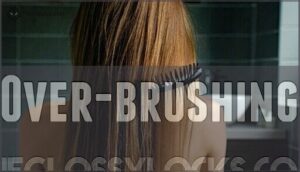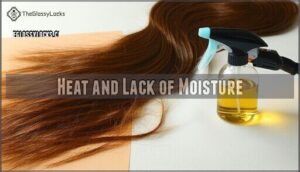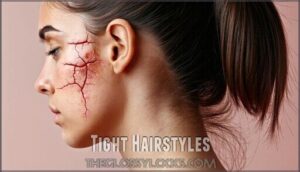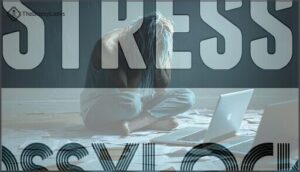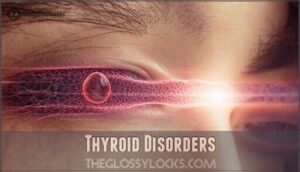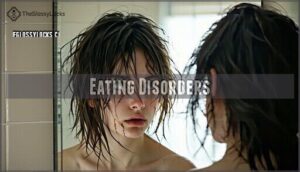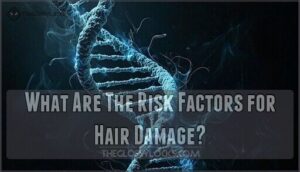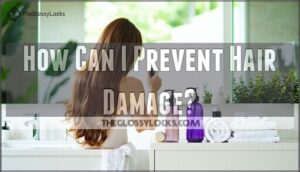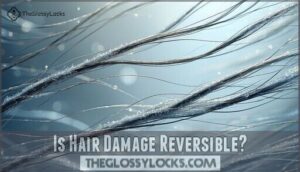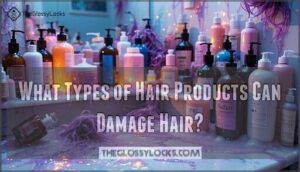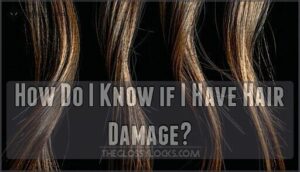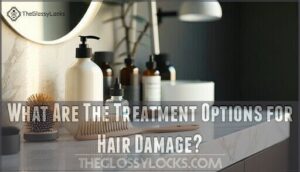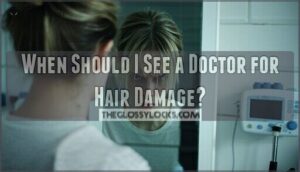This site is supported by our readers. We may earn a commission, at no cost to you, if you purchase through links.
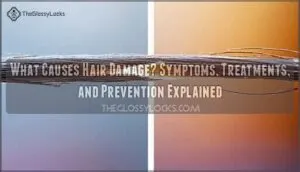 If your hair feels more like straw than silk some mornings, you’re not alone. Blow dryers, hot tools, and endless styling routines can turn even the healthiest head of hair brittle and fragile before you realize what’s happening. Sometimes the culprit is hiding in plain sight—a rough towel, a skipped trim, or a ponytail cinched a little too tight.
If your hair feels more like straw than silk some mornings, you’re not alone. Blow dryers, hot tools, and endless styling routines can turn even the healthiest head of hair brittle and fragile before you realize what’s happening. Sometimes the culprit is hiding in plain sight—a rough towel, a skipped trim, or a ponytail cinched a little too tight.
Knowing what causes hair damage isn’t about scaring you into giving up your favorite styles or products. It’s about spotting the everyday things—habits, stress, diet, even your genes—that quietly chip away at your hair’s strength over time.
By spotting early warning signs and making a few strategic changes, you can protect what’s on your head from root to tip and help your hair stay strong, shiny, and resilient through whatever comes next.
Table Of Contents
- Key Takeaways
- What is Hair Damage?
- What Are The Symptoms of Hair Damage?
- What Causes Hair Damage?
- What Are The Risk Factors for Hair Damage?
- How Can I Prevent Hair Damage?
- Is Hair Damage Reversible?
- What Types of Hair Products Can Damage Hair?
- How Do I Know if I Have Hair Damage?
- What Are The Treatment Options for Hair Damage?
- When Should I See a Doctor for Hair Damage?
- Frequently Asked Questions (FAQs)
- What causes damaged hair?
- What causes hair loss?
- What is hair damage?
- What causes hair breakage?
- What causes daily hair shedding?
- What causes chemical damage to your hair?
- Can I reverse hair damage?
- What types of hair products can damage my hair?
- How do I know if I have hair damage?
- What are the treatment options for hair damage?
- Conclusion
Key Takeaways
- Everyday habits, frequent heat styling, and rough handling are major causes of hair damage that often go unnoticed.
- Tight hairstyles, skipped trims, and nutrient deficiencies further weaken hair, making it prone to breakage and thinning.
- Early signs like split ends, rough texture, and excessive shedding indicate your hair needs prompt changes in care.
- Protecting your hair involves gentle routines, regular conditioning, balanced nutrition, and managing stress for long-term strength.
What is Hair Damage?
If your hair feels rough, frayed, or weaker than usual when you touch it, you’re likely experiencing the first signs of damage. Recognizing damage goes beyond just how it looks—healthy hair is elastic and structured, but damaged hair loses its strength and bounce.
The severity of damage can go from surface dryness to breakage deep within the hair shaft. Common culprits behind hair damage are heat, chemicals, and friction.
Knowing the different kinds of damage can alert you when your hair isn’t as healthy as it should be and what steps might help revive it.
What Are The Symptoms of Hair Damage?
Recognizing the telltale signs of hair damage is like noticing a flat tire on a road trip—sometimes it’s obvious, but other times you have to pay closer attention to realize something isn’t right. Your hair might feel coarser than usual, or individual strands mightn’t reflect light the way they used to.
If you’re wondering what to watch for, be on the alert for these symptoms of hair breakage and damage:
- Persistent hair dryness that no conditioner seems to remedy
- Split ends or “feathering” at the ends of your hair
- Hair thinning or sections that suddenly feel sparse
- Lackluster appearance—when your hair doesn’t have its natural gleam
- Rough texture or hair that’s harder to comb through
These are definite signs of hair breakage needing attention.
What Causes Hair Damage?
Hair can become damaged for many reasons, some of which might surprise you. Your daily routine, health, and environment all contribute.
Keep these everyday culprits in mind when looking out for your hair’s health.
Over-brushing
If you’re constantly running a brush through your hair without thinking twice, you might be setting yourself up for serious breakage and split ends. Wet hair is particularly vulnerable to mechanical damage, so change how often you brush and select the best brush types for your hair texture. Here’s what’s important:
| Factor | Damaging Practice | Better Approach |
|---|---|---|
| Technique | Rough, rapid strokes | Gentle detangling from ends up |
| Timing | Brushing soaking-wet hair | Wait until hair is damp or dry |
| Tools | Hard bristles, metal pins | Soft bristles, wide-tooth combs |
Good hair care involves scalp stimulation without excessive force, preventing hair damage through careful technique.
Heat and Lack of Moisture
While brushing is important, the real trouble often begins when you turn up your flat iron or forget moisturizing treatments. Heat styling harms hair when high temperatures weaken its protective outer layer, leaving strands fragile and likely to break. Without enough moisture, your hair isn’t able to defend itself against heat.
- Use heat protectant sprays before styling to form a barrier between heat tools and your hair shaft
- Deep conditioning treatments once weekly help revive hydration and mend damage from heat exposure
- Use lower heat settings and style less often to reduce ongoing harm while keeping a moisture balance
It’s impossible to overstate how essential hydration is—dry hair snaps easily, so prioritizing treatments and protective styles prevents additional damage.
Towel Drying
Patting your hair dry might seem harmless, but the friction from a rough towel actually tugs at wet strands when they’re at their most vulnerable, leading to breakage you won’t see until it’s too late.
This friction worsens damage because wet hair is more porous, causing it to stretch and snap easily.
Your hair care should feature gentler drying methods—microfiber towels cut down on friction, or you could just let your hair air dry to keep it from breaking and shield your strands from unneeded harm.
Not Having Regular Haircuts
Letting your hair grow without a single snip might seem like the easiest path to longer locks, but those ignored ends will actually split, and the damage will creep up the hair shaft. Scheduling trims every six to eight weeks prevents split ends from getting out of hand, which helps you keep your length.
And the perks of trimming don’t stop there—you’ll also keep your hairstyle looking its best and manage hair damage in the process. Regular cuts are a must for any hair care routine. Healthy ends mean stronger hair that grows longer instead of breaking off.
Diet
Your diet directly affects your hair’s strength and resilience. Protein intake fuels keratin production, and iron levels and vitamin deficiencies affect follicle function. Nutrient shortages—particularly in fatty acids and minerals—disrupt the growth cycle, leading to breakage and thinning.
A healthy diet with sufficient nutrition protects against mineral imbalance. The effect of diet on hair health and diet choices is huge for preventing damage. Often, fixing hair loss means managing nutrient deficiencies through diet and supplements.
Tight Hairstyles
Frequently wearing your hair in tight styles puts stress on and weakens follicles at the roots, which can cause traction alopecia. Styles like braids, buns, and slicked-back ponytails cause the most damage around the hairline and temples. You may see shorter hairs and a sensitive scalp in those spots.
How often you repeat a hairstyle matters—wearing the same tight style every day speeds up the damage. Protective styles are helpful only if they’re loose enough to prevent constant pulling.
Changing up your hairstyles and giving your scalp regular breaks helps prevent lasting hair damage and keeps your follicles healthy.
Stress
Stress affects more than just your mental state—it can force hair follicles into a premature resting phase, which disrupts the growth cycle and leads to noticeable hair loss.
When you’re constantly stressed, your body is flooded with hormones that interfere with hair growth, resulting in increased breakage and thinning.
Taking care of your mental health by using stress-reducing methods—like regular exercise, enough sleep, and relaxation exercises—can help safeguard your hair and minimize stress-related damage.
Thyroid Disorders
Thyroid conditions—including hypothyroidism and hyperthyroidism—disrupt the natural hair growth cycle, pushing follicles into extended resting phases and causing diffuse hair thinning. Research shows up to 40% of individuals with thyroid disorders experience some hair loss, often with changes in hair texture, brittleness, and diminished strength.
Autoimmune thyroid diseases can even trigger autoimmune alopecia in susceptible individuals, increasing genetic risk. The good news? Treatment outcomes get much better once hormone imbalance is corrected through medical care. Often, patients may benefit from nutritional support to encourage hair regrowth and thyroid function.
Eating Disorders
Anorexia and bulimia disrupt your body’s ability to fuel hair follicles, triggering telogen effluvium and significant shedding. Over 60% of individuals with anorexia experience hair loss, often within 2–3 months of severe restriction. Nutritional deficiencies—especially protein, iron, zinc, and B vitamins—weaken hair shafts, causing brittleness and breakage. Hair shaft defects like pili torti appear in over 80% of prolonged cases. The encouraging news? Regrowth outcomes improve dramatically with nutritional rehabilitation, often showing results within 6–12 months.
Common signs you might notice:
- Increased hair in your brush or shower drain
- Dry, brittle strands that snap easily
- Thinning patches across your scalp
- Twisted or structurally weakened hair fibers
- Slowed growth or stubborn bald spots
What Are The Risk Factors for Hair Damage?
Knowing what causes hair damage is helpful, but recognizing your own risk factors empowers you to take action. Several things determine if you’re more likely to experience problems.
Your risk depends on both inherited and changeable factors:
- Genetic predisposition – Hereditary hair loss affects up to 80% of men and 50% of women by age 70, and a family history makes it much more probable.
- Hormonal imbalance – Thyroid issues trigger around 14% of medically-induced hair loss, and menopause contributes to thinning in over 40% of women after 40.
- Autoimmune conditions – Conditions such as alopecia areata affect about 2% of people worldwide, while lupus-related hair loss impacts nearly half of those diagnosed.
- Lifestyle factors and nutritional deficiencies – Smoking increases your risk by 21%, and iron deficiency contributes to shedding in 18% of adults with unexplained loss.
Chemical treatments and excessive hair styling worsen these underlying health conditions, increasing the chances of damage.
How Can I Prevent Hair Damage?
Protecting your hair begins with knowing its needs and identifying habits that could be harming it. Simple changes to your everyday habits can really help keep your hair strong and healthy.
Let’s look at four simple ways you can help protect your hair from unnecessary damage.
Change Haircare Routine
If your hair is damaged—maybe it’s frizzy, has split ends, or feels like straw—changing your haircare can really help. Start by using mild products that won’t dry out your hair, and try not to use heat too much, as that can cause more breakage.
Hydrate your hair with moisturizing treatments and deep conditioners. Consistency is key—a healthy scalp needs regular care. Also, stay away from harsh chemicals and too many treatments.
It takes time to heal damaged hair, so be patient and give your new routine a chance before you expect big changes.
Use a Conditioner
Once you’ve adjusted your routine, adding conditioner is one of the easiest ways to make your hair stronger and better protected. Conditioner options are diverse—rinse-out types replenish moisture after shampooing, and leave-in benefits offer continuous protection against breakage.
How you put it on matters: concentrate on the middle to ends of your hair, where most damage occurs. Select products featuring ingredients such as proteins and natural oils that complement your hair care and target particular issues.
Reduce Stress
Stress often shows in your hair before you even realize it. The effects of ongoing stress can throw off your hair’s growth, leading to breakage and even loss.
That’s why finding ways to manage stress really matters. Simple things like practicing mindfulness, rolling out your yoga mat, or even pausing for a few deep breaths don’t just soothe your mind—they also help shield your hair from stress-related damage, keeping it healthy and reducing the risk of thinning that can happen when tension and hair woes pile up together.
Dietary Changes
Your body requires the proper fuel to grow strong hair, and nutritional deficiencies are a key reason for breakage. A good diet full of protein from sources like eggs and lean meat provides the keratin your strands require—try to get about 48–60 grams each day. Foods high in iron bolster follicle function, and vitamin supplements can fill any gaps in riboflavin, folate, and vitamin D.
Well-rounded meals improve nutrient absorption and the hydrating effects that keep hair strong. If an eating disorder is affecting your nutrition, medical treatment can restore what diet alone can’t. Diet’s effect on hair is clear.
Is Hair Damage Reversible?
How you treat damaged hair hinges on whether the hair follicles are still intact. If they’re, treatments like protein applications can double hair fiber strength and boost elasticity within weeks, effectively targeting breakage and brittleness. Recovery times differ. For non-scarring conditions, regrowth might appear in 6–8 weeks with corticosteroid treatment. Hair generally grows about 1.25 cm each month, so you’ll see noticeable changes after 8–12 weeks.
However, there are limits to what’s reversible. Scarring alopecia destroys follicles, stopping regrowth completely. High doses of radiation can permanently harm follicles, and even if hair does grow back, its texture or color could initially be different. Figuring out if damage is reversible involves evaluating structural harm. Injuries to the cuticle are easier to reverse than damage to the cortex or follicles. New treatments such as stem cell therapies and immune-regulating microneedle patches present encouraging results for restoring hair health.
Your hair care routine is important: avoid heat styling, use moisturizers for your hair type, eat a balanced diet, and consider seeing a professional to check for underlying issues like thyroid problems.
What Types of Hair Products Can Damage Hair?
The very products you rely on to enhance your hair’s beauty may actually be the reason it’s getting worse. Shampoos with high pH levels throw off your hair’s natural balance, which weakens the strands and makes them more prone to breakage.
Treatments like bleaching and coloring go deep into the hair shaft, causing structural damage that leaves it fragile. Extensions and weaves put constant stress on your roots, which can lead to hair loss from traction.
Even seemingly harmless styling products with harsh ingredients rob your hair of its natural oils. A review of product ingredients shows that sulfates, alcohols, and synthetic fragrances are often to blame.
Just because a product is natural doesn’t mean it’s safe—using too much of anything can be harmful.
How Do I Know if I Have Hair Damage?
Recognizing the early indicators can be the difference between saving your hair and watching it worsen. Your hair gives obvious signs when it’s unhealthy, and learning to interpret them allows you to act before minor damage becomes permanent.
These are the major signs of hair breakage you shouldn’t ignore:
- Split ends that fork at the ends, indicating fragile strands that require trimming
- Excessive shedding beyond the usual 50-100 strands daily, leaving clumps in your brush
- Texture changes where once-smooth hair feels rough, brittle, or straw-like to the touch
- Failed elasticity test—healthy hair stretches then returns to normal, but damaged hair snaps instantly when tugged
- High porosity levels causing your hair to absorb water rapidly but lose moisture just as fast
Try this: take a single strand between your fingers and gently stretch it. If it breaks instantly rather than extending slightly first, you’re dealing with damaged hair that requires prompt care.
What Are The Treatment Options for Hair Damage?
Do you wonder if you can bring your hair back to life, or if certain types of damage require more than just a quick fix? Start with gentle conditioning and intense treatments for breakage—like nourishing masks and cutting back on heat.
For tough situations, Minoxidil can encourage regrowth, and some oral medications and prescriptions can help with hormone-related hair loss. Hair transplants offer long-term results if follicles are no longer responding, and PRP injections—where your own platelets are injected—may kickstart growth.
There’s no one-size-fits-all answer. Sometimes, changing your usual hair care is enough, but serious problems may require medical interventions. Treating damaged hair means finding the right solutions for your hair’s unique needs, one step at a time.
When Should I See a Doctor for Hair Damage?
If home treatments aren’t giving you the results you want, or your hair loss feels sudden or severe, it’s a good idea to get a doctor’s opinion. See a dermatologist if you notice:
- Persistent breakage or excessive hair shedding that won’t stop
- Sudden loss, patchy thinning, or scalp symptoms like redness or scaling
- Signs of underlying health conditions—the earlier, the better for treatment effectiveness and long-term hair health.
Frequently Asked Questions (FAQs)
What causes damaged hair?
Chemical exposure from dyes or chemical treatments, product buildup, environmental factors like sun or pollution, genetic predisposition, and medication side-effects can all play a role in different types of hair damage, leading to hair breakage or weakened strands.
What causes hair loss?
Hair loss occurs for many reasons, such as Genetic Predisposition, Hormonal Imbalances, Scalp Infections, Autoimmune Diseases like alopecia, or Medication Side-Effects.
Each disrupts hair follicles, causing shedding that often requires specialized hair loss treatments.
What is hair damage?
When we talk about hair damage, we’re really describing changes to the hair shaft’s structure that can take away its natural strength and flexibility.
Depending on damage severity, you’ll see types like split ends, dryness, or breakage—signs of compromised hair structure.
What causes hair breakage?
Think it’s just about bad hair days? Think again—hair breakage often traces to Chemical Exposure, rough Styling Practices, Mechanical Stress, Nutritional Deficiencies, or Genetic Predisposition.
Understanding what causes hair breakage helps you choose the right treatments.
What causes daily hair shedding?
Losing about 50-100 hairs daily is normal, thanks to the natural growth cycle.
Significant increases, known as hair shedding or Telogen Effluvium, can stem from stress levels, medication side effects, seasonal hair loss, or postpartum shedding.
What causes chemical damage to your hair?
When hair is saturated with bleach, relaxers, or harsh perm formulas, it craves moisture because chemical processes strip away natural oils and weaken its structure.
Therefore, overuse of chemical treatments or product buildup leads to breakage and obvious chemical damage.
Can I reverse hair damage?
With the right hair care routine, targeted products, and some professional help, it’s possible to reverse certain types of hair damage.
How quickly your hair bounces back depends on the severity of the damage, how effective your products are, and the habits you stick with.
So, being consistent is essential for both treating and preventing hair breakage.
What types of hair products can damage my hair?
It’s ironic how a product promising luster can leave your hair looking dull and damaged.
Hair products loaded with sulfates, high pH levels, harsh alcohols, and chemical treatments increase the potential for allergic reactions and lasting damage.
How do I know if I have hair damage?
Notice dull strands, split ends, or breakage? Texture changes—such as roughness or brittleness—can signal damage.
Unhealthy scalp or reduced elasticity strengthens the case. For an accurate damage self-assessment, consider a professional diagnosis of scalp health and hair breakage.
What are the treatment options for hair damage?
If breakage occurs, you can try at-home solutions like coconut oil or deep-conditioning masks, switch to protein treatments, or get professional hair treatments.
Minoxidil, PRP injections, prescription medications, and even hair transplants can also help bring back lost volume.
Conclusion
It’s funny how something you handle every day can still get damaged before you realize it—the causes of hair damage aren’t always obvious. It’s not just heat or tight hairstyles; your daily habits, diet, and overall health also matter.
Catching problems early gives you an advantage. With the proper adjustments, most hair issues can be managed or even reversed. Pay attention, and your hair’s strength and luster can become what you’re known for, not a constant worry.
- https://www.nih.gov/news-events/news-releases/hair-straightening-chemicals-associated-higher-uterine-cancer-risk
- https://www.seejph.com/index.php/seejph/article/download/2654/1760/3911
- https://newatlas.com/society-health/heated-hair-products-nanoparticles/
- https://www.schwarzkopf-professional.com/gb/en/inspiration-education/ask/avoid-heat-damage-when-using-heated-hair-styling-tools.html
- https://www.thedyelot.com/blog-archive/why-you-should-avoid-heat-styling-tools


